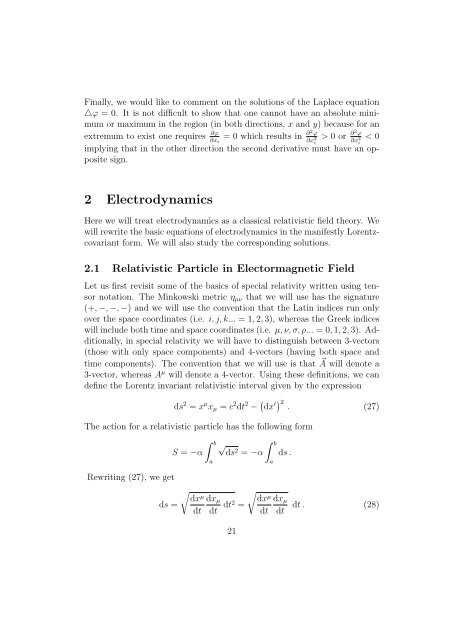Topics in Classical Electrodynamics
Topics in Classical Electrodynamics
Topics in Classical Electrodynamics
Create successful ePaper yourself
Turn your PDF publications into a flip-book with our unique Google optimized e-Paper software.
F<strong>in</strong>ally, we would like to comment on the solutions of the Laplace equation<br />
△ϕ = 0. It is not difficult to show that one cannot have an absolute m<strong>in</strong>imum<br />
or maximum <strong>in</strong> the region (<strong>in</strong> both directions, x and y) because for an<br />
< 0<br />
imply<strong>in</strong>g that <strong>in</strong> the other direction the second derivative must have an opposite<br />
sign.<br />
extremum to exist one requires ∂ϕ<br />
∂x i<br />
= 0 which results <strong>in</strong> ∂2 ϕ<br />
∂x 2 i<br />
> 0 or ∂2 ϕ<br />
∂x 2 i<br />
2 <strong>Electrodynamics</strong><br />
Here we will treat electrodynamics as a classical relativistic field theory. We<br />
will rewrite the basic equations of electrodynamics <strong>in</strong> the manifestly Lorentzcovariant<br />
form. We will also study the correspond<strong>in</strong>g solutions.<br />
2.1 Relativistic Particle <strong>in</strong> Electormagnetic Field<br />
Let us first revisit some of the basics of special relativity written us<strong>in</strong>g tensor<br />
notation. The M<strong>in</strong>kowski metric η µν that we will use has the signature<br />
(+, −, −, −) and we will use the convention that the Lat<strong>in</strong> <strong>in</strong>dices run only<br />
over the space coord<strong>in</strong>ates (i.e. i, j, k... = 1, 2, 3), whereas the Greek <strong>in</strong>dices<br />
will <strong>in</strong>clude both time and space coord<strong>in</strong>ates (i.e. µ, ν, σ, ρ... = 0, 1, 2, 3). Additionally,<br />
<strong>in</strong> special relativity we will have to dist<strong>in</strong>guish between 3-vectors<br />
(those with only space components) and 4-vectors (hav<strong>in</strong>g both space and<br />
time components). The convention that we will use is that ⃗ A will denote a<br />
3-vector, whereas A µ will denote a 4-vector. Us<strong>in</strong>g these def<strong>in</strong>itions, we can<br />
def<strong>in</strong>e the Lorentz <strong>in</strong>variant relativistic <strong>in</strong>terval given by the expression<br />
ds 2 = x µ x µ = c 2 dt 2 − ( dx i) 2<br />
. (27)<br />
The action for a relativistic particle has the follow<strong>in</strong>g form<br />
Rewrit<strong>in</strong>g (27), we get<br />
S = −α<br />
∫ b<br />
a<br />
√<br />
∫ b<br />
ds2 = −α ds .<br />
a<br />
ds =<br />
√<br />
dx<br />
µ<br />
dt<br />
dx µ<br />
dt dt2 =<br />
√<br />
dx<br />
µ<br />
dt<br />
dx µ<br />
dt<br />
dt . (28)<br />
21
















